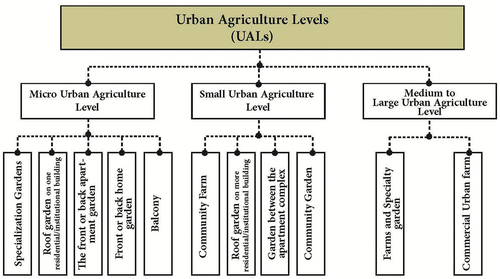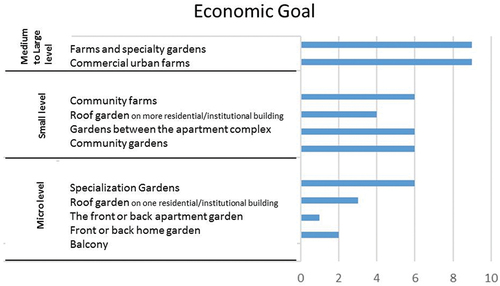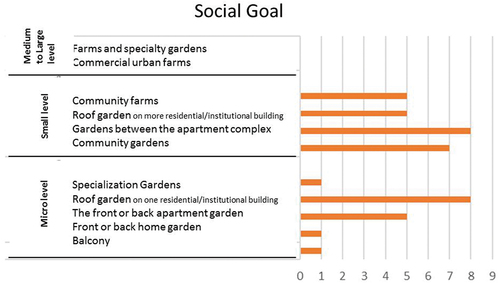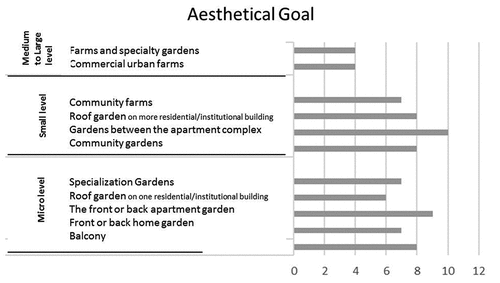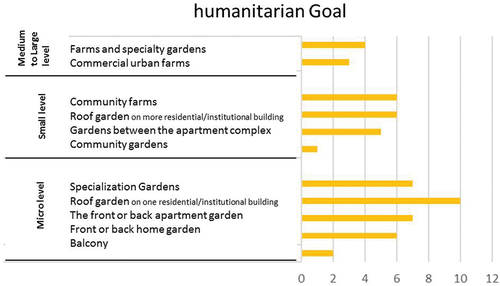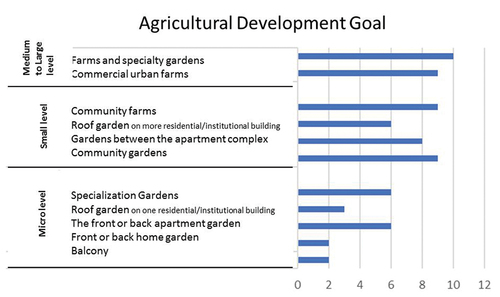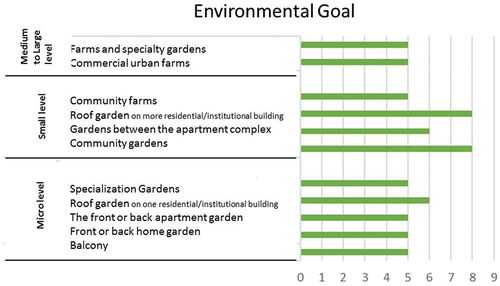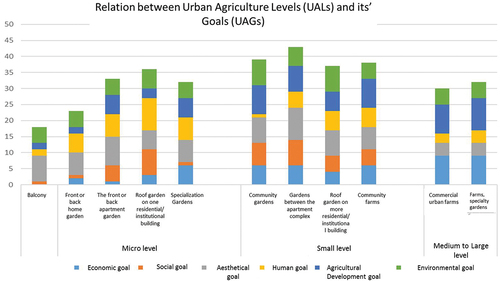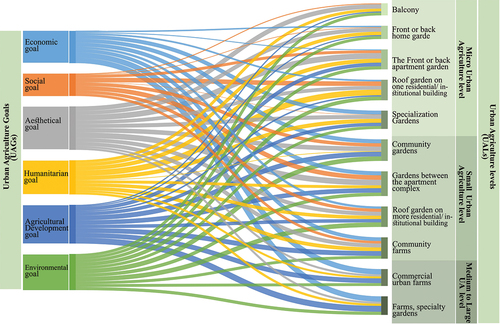ABSTRACT
Urban agriculture is essential to support sustainable urban development by achieving the urban agriculture goals (UAGs), which are economic, environmental, social, agricultural, esthetic and humanitarian goals. Urban agriculture includes three main levels, starting with precision urban agriculture, followed by the level of small urban agriculture, and then gradually moving to medium and large urban agriculture. These different levels are tightly connected to what UAGs aims to achievement. The research aims to providing a framework for selecting the appropriate level of urban agriculture according to the urban agriculture required goals, through finding the interrelationship between urban agriculture levels (UALs) and the related urban agriculture goals (UAGs) for each level. The research depends on experts’ questionnaires to conclude the varying relationships of the impacts of urban agriculture levels which are micro, small, and medium levels on the urban agriculture goals, which have been classified into groups, according to the most and the least affected by the UALs. Where the small scale of urban agriculture levels came in the lead of supporting the achievement of the social, environmental, and urban esthetic urban agriculture goals, however the medium- to large urban agriculture level came in the lead of supporting the achievement of agricultural and economic urban agriculture goals. This result will be beneficial to decision-makers in distributions of urban agriculture in deferent levels to determine the most appropriate level of urban agriculture in cities and residential complexes, according to the desired urban agriculture goals, according to the experts’ results.
Introduction
Urban agriculture are among the most vital topics that garner widespread attention at all levels of the Arab, regional, and global communities [Citation1], it contributes to food security and the stability of security conditions by utilizing available resources and abandoned spaces within city structural plans for food cultivation [Citation2]. Urban Agriculture (UA) can be defined as the growing, processing, and distribution of food and other products through plant cultivation and seldom raising livestock in and around cities for feeding local populations [Citation3,Citation4].
The FAO defines urban agriculture as small areas such as abandoned plots of land, gardens, roads, balconies, and basins that are located inside the city to grow crops and raise small livestock, for the purpose of self-consumption or selling in neighborhood markets [Citation5]. According to the 2013 World Bank Report, urban agriculture is defined as the activity of producing goods that takes place within a city [Citation6].
There are many organizations and parties interested in urban agricultural practices as one of the factors of global food security. There have been many reports related to urban agriculture from the perspective of global consumption and food security [Citation7] and the ability of these practices to achieve self-sufficiency for communities in developing countries [Citation8]. There are also many scientific researches, which are usually limited to studying the components, dimensions and objectives of urban agriculture and the relationship of urban agriculture to one or both of the urban, administrative [Citation9], social [Citation10], economic or environmental aspects [Citation11].
There is some scientific research that links urban agriculture with the most important global issues such as food security, climate change, sustainable development goals, social and economic sustainability, and the resilience of cities.
As for the local level in the research, the researches that studied urban agriculture in Egypt followed the previous research patterns [Citation12,Citation13]. And despite the multiplicity of research related to urban agriculture, the interrelationships of the goals of urban agriculture with its different levels were not addressed, as most of the research came in presenting the goals as a utilitarian value for urban agriculture, and the studies didn’t find the interrelationships between the different goals and the levels of urban agriculture, which helps in a deeper understanding of those goals and the extent of their impact on urban farming practices.
Methods
The research focuses on determining the impact of UALs on achieving the UAGs. It aims to provide a framework for selecting the level of urban agriculture that supporting the achievement of urban agricultural goals. The methodology of the research is based on two parts, the first part is discussing: Urban Agriculture goals which include economic, social, economic, Humanitarian, Agricultural and development, and Environmental goals. In addition of discussing the Urban Agriculture Levels which range from the micro scale to the large scale. The second part is arranging the UAGs from the most affected by UALs to the least, depending on structured interviews and experts’ questionnaires for a diverse sample of 30 experts in this field from researchers, academics, and agricultural practitioners. The experts’ questionnaires were designed into 29 questions distributed into three sections; the first section included 3 questions about the experts’ personal information. The second section dealt with 20 questions about the agricultural background for the experts. And the third section dealt with 6 questions included the six urban agriculture goals, and its relation with the applications of UALs. That aiming to arranging the UALs from the most affected by UAGs to the least for each goal, by choosing from the applications of AULs. And by aggregating the number of times each the type of UALs was selected during each goal and collecting them, it was possible to calculate the number of points collected for each goal with help of Microsoft Excel program. Accordingly, it was possible to arrange the UAGs from the most affected by UALs to the least, aiming to provide a framework for selecting the level of urban agriculture based on the desired goal.
Urban Agriculture Goals (UAGs)
Cities and communities can reap numerous urban, social, economic, environmental, and esthetic benefits by establishing and practicing successful urban agriculture at all three levels [Citation14]. The success of practicing urban agriculture depends on defining the desired goals, as the urban agriculture goals are divided into six goals: economic goal, social goal, esthetical goal, Humanitarian goal, Agricultural Development goal, environmental goal [Citation15] as shown in , so these UAGs are important when developing and designing policies for urban agricultural models in urban and semi-urban areas.
Figure 1. Urban agriculture dimensions.
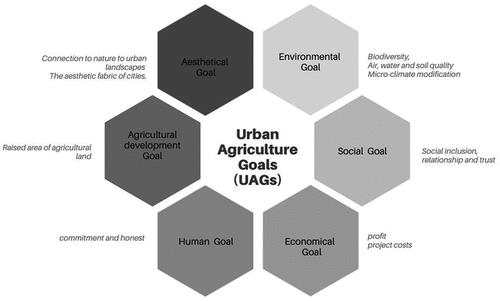
Urban planners confront a significant task in achieving esthetic urban goals. They determine how to get advantages and address the issues that arise from urban agriculture activities [Citation17]. In many peri-urban and urban locations, there is no distinct policy for food production [Citation18] Therefore, land-use concerns, such as land availability, access to land, and land use suitability, are major considerations in planning policy for urban agriculture [Citation17–19]
In terms of the environmental goal, urban agriculture within cities offers a number of benefits to the environment, including increased biodiversity, pollinator habitats, and nutrient-rich soils through compost production, these operations require mindful resource management throughout the food production cycle to prevent undue stresses on urban services, natural areas, and human resources [Citation20]. Also Planting tree crops and diverse plant species in urban areas naturally filters air and water, promotes carbon sequestration in soils, provides shade, and can help moderate high temperatures [Citation21]. Urban agriculture strengthens many ecosystem services, such as improving human health, food access to local communities [Citation21–23]. In addition, increasing access to fresh and nutritious food, it also strengthens supporting, provisioning, regulating, and cultural/social ecosystem services. These benefits include soil formation and primary production for supporting services, food, fiber, fresh water and infra-structure foundation of provisioning services, micro-climate modification, flood control, water purification, soil bioremediation and decontamination for regulating services [Citation24]. So the environmental goal contributes to improving local climate and reducing the effects of climate change and the phenomenon of heat islands, as well as enhancing the biodiversity [Citation25], in addition to increasing the production of fresh food [Citation26]. Urban agriculture is generally considered to be an environmentally sustainable activity [Citation27].
The agricultural development goals are represented in agriculture’s role in connecting the city and the countryside, as well as preserving cultivated lands and increasing the percentage of cultivated fields, which results in lower costs associated with fertilizer production, import, and use [Citation28]. The Humanitarian goal of urban agriculture is one of the basics of the ecosystem that supports the quality of life of individuals [Citation29], and among those aims is the process of self-sufficiency and learning related to urban agriculture, so that livelihoods and ecosystems can be sustained and nurtured. This approach has a direct impact on the determinants of urban nutrition and agriculture, where everyone has the ability to earn a decent income, access basic public services, and enjoy an inclusive social environment characterized by diversity, uniqueness, and a common culture [Citation30]. The social goal is represented by participants’ social dimensions being enhanced through community engagement and knowledge and experience exchange, which leads to societal sustainability and the formation of a network of social and human ties. It also allows diverse community organizations to interact by allowing them to work together in a communal garden [Citation31]. Community participation, social capital, and job creation are all examples of social goal. Urban agriculture is one of the economic success drivers because it creates new types of urban income, such as beekeeping and self-harvesting gardens, as well as new forms of leisure and a work-life balance. It can also help to bridge the gap in the food chain and Increase livestock and poultry wealth by generating innovative approaches to individual self-supply [Citation32]. It also helps in achieving financial returns and providing job opportunities.
esthetical goal presents through urban agriculture which brings beauty, community engagement, and a connection with nature through urban landscapes, enriching the esthetic fabric of cities. The need for esthetic understanding of the urban agriculture landscape is even more significant, as this offers a different mode of landscape interpretations [Citation33]. Nonetheless, the gardens and parks created as a result of community gardening often appropriated rural or pastoral esthetics [Citation33]. Urban agriculture bring to the city a different type of gardening culture, one that is more agricultural than gardening, the need for esthetic understanding of the urban agricultural landscape is even more significant, as this offers a different mode of landscape interpretations [Citation34]. Agricultural activities are themselves profoundly creative endeavors that when infused with art and carried out with a high level of skill, tradition, ritual and intentionality can themselves become a form of art and the basis of larger culture. Certainly, the songs, dance, storytelling, basketry, fabric designs, and visual art of many ancient and surviving cultures revolve around food [Citation35]. Urban agriculture strengthens esthetical value and beauty. shows the goals of urban agriculture.
Table 1. Goals of urban agriculture.
Urban Agriculture Levels (UALs)
Urban agriculture is categorized into three main levels: micro, small, and medium to large urban agriculture. According to the United Nations Urban Development Program for the year 1996, these three levels include various applications of urban agriculture, starting from applications of micro urban agriculture level as the cultivation of rooftops (roof garden) on one residential/institutional building, small spaces inside homes (Balcony), to backyards (the front or back apartment garden), semi-private spaces (front or back home garden), and Specialization Gardens. The second level is small urban agriculture level as community gardens, and gardens between the apartment complex, Roof garden on more residential/institutional building, and Community farms. As well as urban agriculture occurring on the divisions of large and diverse plots of land as commercial urban farms and farms and specialty gardens, which represents applications of medium- to large urban agriculture level. Whereas micro urban agriculture level occupies less than 500 m2, small urban agriculture level occupies between 500 and 1000 m2, and medium- to large urban agriculture level occupies more than 1000 m2 [Citation14]. shows the levels of urban agriculture according to scale and size.
Questionnaire
The questionnaire focuses on the relationship between urban agriculture levels and its goals. The following are either economic goal, such as increasing the income of farmers’ families, providing an additional source of income, or achieving a satisfactory financial return, or social goal, such as achieving social cohesion and community participation among the population, or environmental goal, such as improving the overall climate and landscape. In terms of agricultural development, the goal is to increase the amount of cultivated land in the city. The fifth goal is a Humanitarian goal, such as self-education and the development of skills and talents. The esthetical goal is the final goal. The patterns of urban agriculture vary between micro, small, medium, and large-scale agriculture, and each of the three levels includes several applications of urban agriculture, where each application is characterized and corresponds to several goals, and may be suitable for only one goal, as stated in the questionnaire results. The experts’ questionnaires were designed into 29 questions distributed into three sections; the first section included 3 questions about the experts’ personal information. The second section dealt with 20 questions about the agricultural background for the experts. And the third section dealt with 6 questions included the six urban agriculture goals, and its relation with the applications of UALs. That aiming to arranging the UALs from the most affected by UAGs to the least for each goal, by choosing from the 11 applications of UALs. And by aggregating the number of times each the type of UALs was selected during each goal and collecting them, it was possible to calculate the number of points collected for each goal with help of Microsoft Excel program. Accordingly, it was possible to arrange the UAGs from the most affected by UALs to the least, aiming to provide a framework for selecting the level of urban agriculture based on the desired goal.
Results
In the light of the expert questionnaire results, this section presents the percentage of the 11 applications of AULs in the UAGs. Accordingly, it can be determined to the impact of UALs on achieving the UAGs. By calculating the numerical average of the expert questionnaire results, the percentage of the AULs to supporting the achievement of the UAGs could be concluded as shown in , and it is presented in . Based on previous results, it is noticeable that:
Economic goal has been achieved as a major goal in medium- to large-scale urban agriculture level, whether for farms and specialty gardens, and commercial urban farms. It becomes clear that the impact of the economic goal and its potential to generate a profitable financial return arises in the higher urban agriculture levels, since it’s connected to the vast farmlands
Social goal is more successfully achieved in small-scale urban agriculture level, as in its application such as: community farms, roof garden on more residential/institutional building, the Gardens between the apartment complex, and Community gardens. Where these applications support the cooperation of residents and participatory capacity, which supports social urban agriculture goal in those spaces. While the social goal of UAGs has not been achieved at the medium to large-scale urban agriculture level.
Esthetic goals have been achieveD at the small-scale urban agriculture level, whether community farms, roof garden on more residential/institutional building, the gardens between the apartment complex, and community gardens. It was achieved as a dominates goal of the urban agriculture goals at the micro-scale urban agriculture level, as on the following applications : balcony, front or back home garden, the front or back apartment garden, roof garden on one residential/institutional building, and specialization gardens.
Humanitarian goal has been achieved clearly at the micro-scale urban agriculture level, as on the following applications: balcony, front or back home garden, the front or back apartment garden, roof garden on one residential/institutional building, and specialization gardens. As well as achieved at the small-scale and medium- to large-scale urban agriculture levels in close proportions (very closely).
Agricultural development goal has been achieved clearly in the medium to large-scale urban agriculture level, as farms and specialty gardens, and commercial urban farms
Environmental goal has been achieved in the small-scale urban agriculture level, whether community farms, roof garden on more residential/institutional buildings, the gardens between the apartment complex, and community gardens. It was achieved very closely at the medium to large-scale urban agriculture level, as farms and specialty gardens, and commercial urban farms.
Figure 3. Shows the urban agriculture goals (UAGs) most affected by urban agriculture levels (UALs).
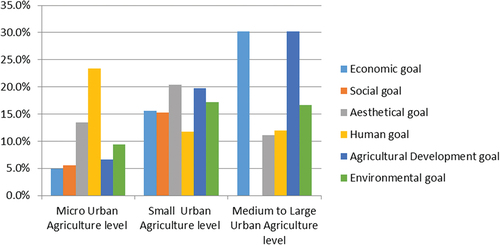
Table 2. The percentage of the AULs to supporting the achievement of the UAGs.
Based on the foregoing, finding the urban agriculture goals (UAGs) most affected by urban agriculture levels (UALs) are the agriculture development goal and the economic goal at the medium to large-scale urban agriculture level, followed by the esthetic goal in the small-scale urban agriculture level, then the environmental goal, the social goal, and finally the Humanitarian goal at the small-scale urban agriculture level. As well as it was noted the six urban agriculture goals has been achieved during the small-scale urban agriculture level in closely proportions except the esthetic goal has been achieved as a dominated goal of UAGs.
Discussions
This section discusses the relationships of the impacts of urban agriculture levels on the six urban agriculture goals which are the economic goal, the social goal, the esthetical goal, the Humanitarian goal, the agricultural Development goal, and the environmental goal. The discussion is based on the data analysis to determining the urban agriculture levels that are the most supportive in achieving each goal separately by calculating the numerical averages according to the experts’ questionnaire results for a diverse sample of 30 academic and nonacademic experts in the field.
Economic goal
Based on the analyzing of the experts’ questionnaire results, it was possible to determine the urban agriculture levels and its applications that are most influential in support the achievement of the economic goal with its potential benefits that supporting bridging the gap in the food chain, increases livestock and poultry wealth, achieving financial returns, and providing job opportunities. It could determine UALs that meet the desired the economic goal, in descending order, as follows: commercial urban farms, and farms & specialty gardens, at the medium to large-scale urban agriculture level. Followed by community farms, community gardens, and gardens between the apartment complexes at the small-scale urban agriculture level. Specialized gardens at micro-scale urban agriculture level also appear in the same proportion as shown in .
Social goal
According to experts’ questionnaire results, the applications of urban agriculture levels that meet the desired social goal through raise the awareness, self-learning, sharing knowledge, community participate, and increasing the social cohesion, in descending order, as follows: Gardens between the apartment complex at the small-scale urban agriculture level, and the roof garden on one residential/institutional building at the micro-scale urban agriculture level has been equal value. It followed by community gardens at the small-scale urban agriculture level. Then comes after that community farms, and roof garden on more residential/institutional building at the small-scale urban agriculture level. And equal to it the front or back apartment garden at the micro-scale urban agriculture level as shown in .
Esthetic goal
The esthetic goal of urban agriculture included achieving a connection with nature through the urban landscape of the city and residential complex, and the esthetic fabric of cities. Based on the analysis results of experts’ questionnaire, it showed that the most influential UALs in supporting the achievement of the esthetic goal were all micro-level applications and small-scale urban agriculture, and they appeared very similar. The application of gardens among the residential complex at small-scale urban agriculture came to the fore as shown in .
Humanitarian goal
The achievement of the humanitarian goal supports the improving the quality of life, and food security (Self-sufficiency), through urban agriculture applications. According to the analysis of the results of the experts’ questionnaire, the application of roof garden on one residential/institutional building at the micro-scale was the most influential in supporting the achievement of the humanitarian goal with its potential benefits. This is followed by specialization gardens, and the front or back apartment garden at the micro-scale urban agriculture level, then the application of Front or back home garden. As well as the application of community farms, and roof gardens on more residential/institutional buildings at the small-scale urban agriculture level, as shown in .
Agricultural and development goals
Based on the analyzing of the experts’ questionnaire results, it was possible to determine the urban agriculture levels and its applications that are most influential in supporting the achievement of the agricultural development goal with its potential benefits that Developing agricultural productivity, increasing crops diversity, and Increasing agricultural. It could determine the applications that meet the desired the agricultural development goal, in descending order, as follows: The results for the applications of farms and specialty gardens are converging with the applications of commercial urban farms at the Medium to Large-scale urban agriculture level, as well as the applications of community farms, and community gardens at the small-scale urban agriculture level, as shown in .
Environmental goal
According to experts’ questionnaire results, the applications of urban agriculture levels that meet desired Environmental goal, through enhancing the biodiversity, reducing effects of climate change, and improving local climate, in descending order, as follows: came to the fore, the application of roof garden on more residential/institutional building, and community gardens at the small-scale urban agriculture level. It is followed by gardens between the apartment complex at the small-scale urban agriculture level, and roof garden on one residential/institutional building at the micro-scale urban agriculture level, as shown in .
All UALs has the potential to achieve the UAGs in a varying extent. The linkages between the urban agriculture levels and its goals vary. And the extent of its influence varies from one level to another. shows the relationship between urban agriculture levels and its six different goals.Conclusions
It was clear that there is varying relationships of the impacts of urban agriculture levels which are micro, small, and medium and large levels on the urban agriculture goals, which have been classified according to the most and the least affected by the UALs. It has appeared that the goals most affected by the micro level of urban agriculture are the humanitarian and esthetic goals of urban agriculture. While the least affected goal is the economical goal. And the goals most affected by the small level of urban agriculture are the social, environmental and agricultural development goals of urban agriculture. While the least affected goal is the humanitarian goal. And it has appeared that the goals most affected by the medium and large levels of urban agriculture are the agricultural and economic development goals of urban agriculture, while the least affected goal is the social goal. The future direction of research should focus on developing a framework to achieve the goals most affected at each level of urban agriculture. shows a framework for selecting the level of urban agriculture (UALs) that supports the achievement of urban agricultural goals (UAGs).
Disclosure statement
No potential conflict of interest was reported by the authors.
References
- Food and Agriculture Organization of the United Nations (FAO). The future of food and agriculture – trends and challenges, Rome. Food and Agriculture Organization of the United Nations (FAO); 2017.
- Hallett ST, Hoagland LO, Toner EM. Urban agriculture: environmental, economic, and social perspectives. In: Janick J, editor Horticultural reviews, New Jersey. United state: John Wiley, Sons. Inc; 2016. p. 65–109.
- Goldstein MI. Urban agriculture: a sixteen city survey of urban agriculture practices across the country. Georgia: Turner Environmental Law Clinic; 2011.
- Hendrickson MK, Porth MA. Urban agriculture - best practices and possibilities. Columbia: University Of Missouri Division of Applied Social Sciences; 2012.
- FAO, Rikolto and RUAF. Urban and peri-urban agriculture sourcebook – from production to food systems. Rome: FAO and Rikolto; 2022.
- The World Bank. The World Bank. Urban agriculture: findings from four city case studies, urban development series knowledge, no. 18. Washington, D.C: Urban Development & Resilience Unit, The World Bank; 2013;87.
- Martin-Moreau M, Ménascé D. Urban agriculture: another way to feed cities, special issue 20, Franca. The journal of field actions, Field Actions Science Reports; 2019
- Food and Agriculture Organization of the United Nations (FAO). The Place of urban and peri-urban agriculture (UPA) in national FOOD security programmes. Food and Agriculture Organization of the United Nations (FAO); 2011.
- Food and Agriculture Organization of the United Nations and International Fund for Agricultural Development. United Nations Decade of Family Farming 2019-2028 The Future of Family Farming in the Context of the 2030 Agenda. Food and Agriculture Organization of the United Nations and International Fund for Agricultural Development: Rome; 2019.
- Orsini FR, Kahane RE, Womdim RE, et al. Urban agriculture in the developing world: a review. Agron Sustain Dev. 2013;33:695–720. doi: 10.1007/s13593-013-0143-z
- Olsson EGA, Kerselaers EV, Søderkvist Kristensen L, et al. Peri-urban food production and its relation to urban resilience. Sustainability. 2016;8(12):1340. doi: 10.3390/su8121340
- Kamel I, El Bilali H. Urban and peri-urban agriculture in Egypt. AGROFOR Int J. 2022;7(1):48–56.
- Daburon A, Alary V, Ali A, et al. Urban and Peri- diversity of family Farming around the World. In: Bosc P, Sourisseau J, Bonnal P, Gasselin P, Valette É, and Bélières J, editors. Diversity of family Farming around the World. dordrecht: Springer; 2018;341.
- Guyot Phung C. Implications of the circular economy and digital transition on skills and green jobs in the plastics industry, field Actions science reports. J Field Actions. 2019;19:100107. Special Issue.
- Clerino P, Fargue-Lelievre A. Formalizing objectives and criteria for urban agriculture Sustainability with a participatory approach. Sustainability. 2020;12:12. doi: 10.3390/su12187503
- Olsson EGA, Kerselaers E, Søderkvist Kristensen L, et al. Peri-urban food production and its relation to urban resilience. Sustainability. 2016;8(12):1340. doi: 10.3390/su8121340
- Quon S, Idrc, Cities Feeding People Program Initiative. Planning for urban agriculture: a review of tools and strategies for urban planners. International Development Research Centrer. 1999;25.
- Olsson EGA, Kerselaers E, Søderkvist Kristensen L, et al. Peri-urban food production and its relation to urban resilience. Sustainability. 2016;8(12):1340. doi: 10.3390/su8121340
- Konijnendijk C, Sadio S, Randrup T, et al. Urban and peri-urban forestry in a development context - strategy and implementation. J Arbori. 2004;30(5):269–276. doi: 10.48044/jauf.2004.032
- Papanek A, Campbell CG, Wooten H. Social and community benefits and limitations of urban agriculture, department of family, youth and community sciences, UF/IFAS. 2023;2023(1) doi: 10.32473/edis-fy1517-2023.
- Santo R, Palmer AKim B. Vacant lots to vibrant plots: areview of the benefits and limitations of urban agriculture, Johns Hopkins center for alivable future. Baltimore: Johns hopkins center for a livable future; 2016.
- Oberholtzer L, Dimitri C, Pressman A. Urban agriculture in the United States: characteristics, challenges, and technical assistance needs. J Exten. 2014;52. doi: 10.34068/joe.52.06.28
- Thomas G. Growing greener cities in Latin America and the Caribbean: an FAO report on urban and peri-urban agriculture in the region. Rome, Italy; (2014).
- Shuster W, Dadio S. An applied hydrogeological perspective on the rendering of ecosystem services from urban soils. Chapter 12, advances in soil science: urban soils. Vol. 406. LLC, Boca Raton, FL: CRC Press - Taylor & Francis Group; 2017.
- Orsini F, Kahane R, Nono-Womdim R, et al. Urban agriculture in the developing world: a review. Agron Sustain Dev. 2013;33:695–720. doi: 10.1007/s13593-013-0143-z
- The future of food and agriculture: Trends and challenges. Food and agriculture Organization of the United Nations Rome. Roma: Association for Culture and Education PiNA; 2017.
- Mougeot LJA. Urban agriculture: definition, presence, potentials and risks, and policy Challenges, Cities Feeding People Series. Ottawa: International Development Research Centre; 2000. Report 31.
- Elmqvist T. Urban agriculture: landscapes connecting people, food and biodiversity, the hurbest project. Sweeden: URban Biodiversity and Ecosystem Services, Stockholm Resilience Centre; 2013.
- Núñez-Ríos JE, Aguilar-Gallegos N, Sánchez-García JY, et al. Systemic design for food self-sufficiency in urban areas, sustainability. Sustainability. 2020;12(18):7558. doi: 10.3390/su12187558
- Buić MI, Cunk KA, Kozina JA, et al. Approaching urban agriculture as a social innovation guidelines for the development and implementation of an action plan. Roma: Association for Culture and Education PiNA; 2017.
- Curtis KR, Cowee MW. Direct marketing local food to chefs: chef preferences and perceived obstacles. J Food Distri Res. 2009;40(2):26–36.
- Langemeyer JO, Lopez CR, Mendoza Beltran A, et al. Urban agriculture — a necessary pathway towards urban resilience and global sustainability? Landscape Urban Plann. 2021;210:104055. doi: 10.1016/j.landurbplan.2021.104055
- Choi JM, Kim YN, Park DC. Study on the desirable direction for Korean community gardens. J Resi Environ Instit Korea. 2018;16(1):83–104. doi: 10.22313/reik.2018.16.1.83
- Shin MY, Pae JE. Aesthetic experience of urban agricultural landscape in post-industrial Seoul. South Korea: Seoul National University; 2018.
- Kistler NI. Agriculture a plan for cultivating arts and culture in seattle’s urban agriculture sites. Seattle: Office of Arts and Culture; 2013.

